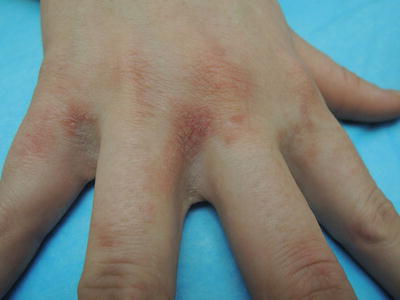, Corinna Eleni Psomadakis2 and Bobby Buka3
(1)
Department of Family Medicine, Mount Sinai School of Medicine Attending Mount Sinai Doctors/Beth Israel Medical Group-Williamsburg, Brooklyn, NY, USA
(2)
School of Medicine Imperial College London, London, UK
(3)
Department of Dermatology, Mount Sinai School of Medicine, New York, NY, USA
Keywords
ScabiesExcoriationPruritusMites Sarcoptes scabiei BurrowsInfestationParasiteEctoparasiteContagiousNeglected disease
Fig. 41.1
Web spaces with a mix of papules and excoriations

Fig. 41.2
Nonspecific excoriations and abrasions with occasional papules arms
Primary Care Visit Report
A 24-year-old female with no past medical history presented with an itchy red rash on her arms and hands that had started 2 weeks prior. The rash started in the webbing between her left thumb and pointer finger, then she noticed it in other finger webbings, and eventually on her upper and lower arms. The rash was itchiest during the day. The patient worked in a kitchen and wore gloves that covered only her hands (not arms) while at work. Sometimes at night her legs itched, but there was no rash on them. The patient had tried cutting gluten out of her diet, which seemed to improve the rash, and also tried moisturizing lotion. She had not tried any steroid creams.
Vitals were normal. On exam, in the webbing between the third and fourth fingers, and fourth and fifth fingers of her right hand there was a 1 cm × 1 cm erythematous scaly rash . Similarly, in the webbing between the thumb and second finger of her left hand, there was a 1 cm × 1 cm erythematous scaly rash. There were multiple scattered erythematous papules on the bilateral upper arms, and a patch of erythematous scale on her right back and hip area.
Due to the improvement with decreased gluten, the possible irritant from wearing gloves at work, and the rash’s spread to the upper arms and right hip, this case was treated as atopic dermatitis and the patient was prescribed hydrocortisone valerate 0.2 % cream—an intermediate potency (Class V) topical steroid—twice daily for 10 days. However, the patient was uninsured, and the steroid cream was too expensive for her, so over-the-counter hydrocortisone cream was recommended first. If there was no improvement noted, the patient was instructed to try the higher strength steroid next. It was also suggested that she try taking shorter warm (not hot) showers and using an over the counter barrier cream, like Eucerin or Aveeno.
Discussion from Dermatology Clinic
Differential Dx
Scabies
Atopic dermatitis
Dyshidrotic eczema
Insect bite
Contact dermatitis
Favored Dx
Dermatology ruled out atopic dermatitis and reclassified the diagnosis as scabies due to the distribution of lesions , excoriations , and associated pruritus .
Overview
Scabies is a highly contagious ectoparasitic infestation by Sarcoptes scabiei mites . Scabies mites are arthropods that do not fly or jump. Scabies are spread by prolonged skin-to-skin contact. Rarely they can also be spread through shared clothing, towels, and linens [1]. Scabies affects people of all ages, races, and socioeconomic levels worldwide, with an estimated incidence of 300 million cases per year [1–4]. Scabies is considered a neglected skin disease by the World Health Organization due to its endemic nature in developing countries, its high economic burden, its association with poverty and its relative neglect by the scientific and healthcare communities [5]. Risk factors making people especially susceptible to mite infestation are immunocompromised status, homelessness, poverty, poor nutritional status, dementia, and living in conditions with overcrowding and poor hygiene [3]. It has also been associated with hospital and nursing home outbreaks [2, 3].
Scabies mites spend their entire life cycle in the epidermis [1, 2]. Adult female mites burrow into the stratum corneum layer of the skin, and lay eggs that typically hatch after 10 days. After a 4–6 week incubation period, hosts experience a hypersensitivity reaction to the mites, their saliva, and excretions [2]. Between 10 and 50 mites are thought to typically infect a host at any time [2–4]. Thousands of mites may be present in immunocompromised hosts, representative of a more severe form of the disease called crusted or Norwegian scabies. This variant is more difficult to treat and can lead to bacterial sepsis [1].
Stay updated, free articles. Join our Telegram channel

Full access? Get Clinical Tree








